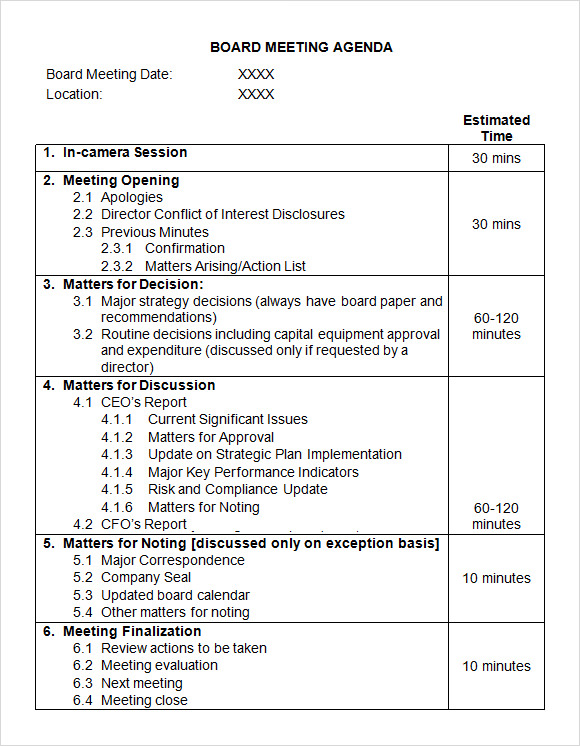

If you’re talking about new computer security policies, you’ll want to have somebody from IT explain the hows and the why’s of it. For example, someone other than the formal meeting leader is often responsible for discussing an item.

When you write the agenda up, as noted earlier, it’s important to identify who is responsible for leading each agenda item. You’ll want your meeting attendees to prepare for the meeting, but did you tell them that when you filled out the template? When you hand out the agenda, you should allow ample time before the meeting, so your attendees can do the appropriate research and think about any questions or concerns they have ahead of time. The idea is to give everyone who wants a chance to speak a chance to do just that. The purpose of time limits is to help you stay on-task – don’t worry if your discussion time goes over, but don’t let anyone dominate the conversation you’re having. It will also give you the leverage you need to ask somebody to “wrap up” if they’re taking too much time on the floor. This will help you stay focused and allow you to add time in for questions and concerns. When planning for each topic, you’ll want to estimate a realistic amount of time for each topic. Without these breaks planned into the agenda, you’ll find your attendees get grumpy. People need bathroom breaks time to grab a glass of water or to simply stretch their legs. Make sure to plan “break time” into the meeting agenda if you anticipate your meeting will be long. Let’s face it long meetings can be a chore, and after a while, it gets to be uncomfortable sitting in meeting chairs without a break. Your attendees will be grateful to know in advance what will be covered, and why their attendance in valuable.Īn effective meeting isn’t usually open-ended. “Discussion: Brainstorm ideas for fundraising event”Įach agenda item should make it clear if you’re giving out information, seeking input for decision-making purposes, or making an actual decision. If you’re seeking new ideas or input, you could list it on the meeting agenda as such: “Vote: Should we open the new computer lab before or after the operating system upgrade?” “When will we be opening the new computer lab?”įor example, if you’ll be voting on an item, you could list the item as such: The questions will also help your attending team members think about the topics ahead of time and prepare questions of their own.Įach meeting agenda item should clearly spell out the purpose of each topic. A simple question and answer format on the agenda can save a lot of headaches, and even encourage your attendees to take notes during the meeting itself.

Most agenda topics are simply short notes that don’t really help the attendees understand what’s being discussed. An effective meeting lets attendees know the game plan in advance so they can mentally prepare themselves for it. Instead of just using short topics, you may want to list your agenda items as questions and answers.įor increased reading comprehension, you may want to list agenda topics as questions the team needs to answer. Use Your Meeting Agenda To Plan Effective MeetingsĪ meeting agenda template typically has a list of topics to be covered, including the name of the person who is going to be speaking on the topic. Being “on the same page” is key for your meetings to be successful.

#Sample meeting agenda software#
If there are problems with the software package that many departments share, then you should provide them with only one solution that everyone agrees with. Whatever is not addressed in the meeting can follow-up in the form of a memo. For example, if you’re updating the word processing software and need to go over new features for the whole office, a meeting on the basics will be helpful for a large audience. Most organizations have blanket issues that affect everyone in the office, because they share the same space and tools. Team meetings take time away from productivity, so stick to topics that affect everyone attending, and call smaller meetings at a later time for other issues that only concern small groups. (If you don’t use their suggested, you should offer them the courtesy of letting them know why.Ĭhoose topics that affect everyone in attendance. It’s important to seek their input and encourage them to suggest agenda items, and why they think these items should be addressed. A good meeting takes planning, preferably the kind that includes the employees or attendees that will be attending your meeting.


 0 kommentar(er)
0 kommentar(er)
